Increased Neural Efficiency in Visual Word Recognition: Evidence from Alterations in Event-Related Potentials and Multiscale Entropy
Abstract
1. Introduction
2. Materials and Methods
2.1. Participants
2.2. Stimuli
2.3. LDT Procedure
2.4. EEG Procedure and Preprocessing
2.5. Behavioural Analyses
2.6. Electrophysiological Analyses
2.6.1. Event-Related Potentials (ERPs)
2.6.2. Multiscale Entropy (MSE)
2.6.3. Partial Least Squares (PLS) Analysis
2.7. Code Availability
3. Results
3.1. Behavioural Results
3.1.1. Response Time
3.1.2. Accuracy
3.2. Event-Related Potentials
3.2.1. Across Session ERPs
3.2.2. Within Session ERPs: Session 1
3.2.3. Within Session ERPs: Session 2
3.2.4. Within Session ERPs: Session 3
3.3. Brain Signal Complexity
3.3.1. Across Session MSE
3.3.2. Within Session MSE: Session 1
3.3.3. Within Session MSE: Session 2
3.3.4. Within Session MSE: Session 3
4. Discussion
5. Conclusions
Author Contributions
Funding
Institutional Review Board Statement
Informed Consent Statement
Data Availability Statement
Acknowledgments
Conflicts of Interest
References
- Laszlo, S.; Federmeier, K.D. Never seem to find the time: Evaluating the physiological time course of visual word recognition with regression analysis of single-item event-related potentials. Lang. Cogn. Neurosci. 2014, 29, 642–661. [Google Scholar] [CrossRef] [PubMed]
- Keuleers, E.; Lacey, P.; Rastle, K.; Brysbaert, M. The British Lexicon Project: Lexical decision data for 28,730 monosyllabic and disyllabic English words. Behav. Res. Methods 2012, 44, 287–304. [Google Scholar] [CrossRef] [PubMed]
- Keuleers, E.; Diependaele, K.; Brysbaert, M. Practice effects in large-scale visual word recognition studies: A lexical decision study on 14,000 Dutch mono- and disyllabic words and nonwords. Front. Psychol. 2010, 1, 1–15. [Google Scholar] [CrossRef] [PubMed]
- Jansma, J.M.; Ramsey, N.F.; Slagter, H.A.; Kahn, R.S. Functional anatomical correlates of controlled and automatic processing. J. Cogn. Neurosci. 2001, 13, 730–743. [Google Scholar] [CrossRef]
- Jonides, J.; Naveh-Benjamin, M.; Palmer, J. Assessing automaticity. Acta Psychol. 1985, 60, 157–171. [Google Scholar] [CrossRef]
- Chein, J.M.; Schneider, W. Neuroimaging studies of practice-related change: fMRI and meta-analytic evidence of a domain-general control network for learning. Cogn. Brain Res. 2005, 25, 607–623. [Google Scholar] [CrossRef] [PubMed]
- Anderson, J.R. Acquisition of cognitive skill. Psychol. Rev. 1982, 89, 369–406. [Google Scholar] [CrossRef]
- Schneider, W.; Chein, J.M. Controlled & automatic processing: Behavior, theory, and biological mechanisms. Cogn. Sci. 2003, 27, 525–559. [Google Scholar] [CrossRef]
- Schneider, W.; Shiffrin, R.M. Controlled and automatic human information processing: I. Detection, search, and attention. Psychol. Rev. 1977, 84, 1–66. [Google Scholar] [CrossRef]
- Megías, A.; Navas, J.F.; Petrova, D.; Cándido, A.; Maldonado, A.; Garcia-Retamero, R.; Catena, A. Neural mechanisms underlying urgent and evaluative behaviors: An fMRI study on the interaction of automatic and controlled processes. Hum. Brain Mapp. 2015, 36, 2853–2864. [Google Scholar] [CrossRef]
- Patel, R.; Spreng, R.N.; Turner, G.R. Functional brain changes following cognitive and motor skills training: A quantitative meta-analysis. Neurorehabil. Neural Repair 2013, 27, 187–199. [Google Scholar] [CrossRef]
- Jeon, H.-A.; Friederici, A.D. What does “being an expert” mean to the brain? Functional specificity and connectivity in expertise. Cereb. Cortex 2016, 27, 5603–5615. [Google Scholar] [CrossRef] [PubMed]
- Pierce, J.E.; McDowell, J.E. Reduced cognitive control demands after practice of saccade tasks in a trial type probability manipulation. J. Cogn. Neurosci. 2017, 29, 368–381. [Google Scholar] [CrossRef] [PubMed]
- Fatsis, S. Word freaks: Heartbreak, Triumph, Genius, and Obsession in the World of Competitive SCRABBLE Players; Penguin Books: New York, NY, USA, 2002. [Google Scholar]
- Tuffiash, M.; Roring, R.W.; Ericsson, K.A. Expert performance in SCRABBLE: Implications for the study of the structure and acquisition of complex skills. J. Exp. Psychol. Appl. 2007, 13, 124–134. [Google Scholar] [CrossRef]
- Protzner, A.B.; Hargreaves, I.S.; Campbell, J.A.; Myers-Stewart, K.; van Hees, S.; Goodyear, B.G.; Sargious, P.; Pexman, P.M. This is your brain on Scrabble: Neural correlates of visual word recognition in competitive Scrabble players as measured during task and resting-state. Cortex 2016, 75, 204–219. [Google Scholar] [CrossRef]
- Van Hees, S.; Seyffarth, S.; Pexman, P.M.; Cortese, F.; Protzner, A.B. An ERP investigation of vertical reading fluency in Scrabble® experts. Brain Res. 2017, 1667, 1–10. [Google Scholar] [CrossRef] [PubMed]
- McIntosh, A.R.; Kovacevic, N.; Itier, R.J. Increased brain signal variability accompanies lower behavioral variability in development. PLoS Comput. Biol. 2008, 4, e1000106. [Google Scholar] [CrossRef]
- Wang, H.; McIntosh, A.R.; Kovacevic, N.; Karachalios, M.; Protzner, A.B. Age-related multiscale changes in brain signal variability in pre-task versus post-task resting-state EEG. J. Cogn. Neurosci. 2016, 28, 971–984. [Google Scholar] [CrossRef] [PubMed]
- Petersen, S.E.; van Mier, H.; Fiez, J.A.; Raichle, M.E. The effects of practice on the functional anatomy of task performance. Proc. Natl. Acad. Sci. USA 1998, 95, 853–860. [Google Scholar] [CrossRef] [PubMed]
- Hong, J.-Y.; Gallanter, E.; Müller-Oehring, E.M.; Schulte, T. Phases of procedural learning and memory: Characterisation with perceptual-motor sequence tasks. J. Cogn. Psychol. 2019, 31, 543–558. [Google Scholar] [CrossRef]
- Gehringer, J.E.; Arpin, D.J.; Heinrichs-Graham, E.; Wilson, T.W.; Kurz, M.J. Neurophysiological changes in the visuomotor network after practicing a motor task. J. Neurophysiol. 2018, 120, 239–249. [Google Scholar] [CrossRef] [PubMed]
- Bentin, S.; Mouchetant-Rostaing, Y.; Giard, M.H.; Echallier, J.F.; Pernier, J. ERP manifestations of processing printed words at different psycholinguistic levels: Time course and scalp distribution. J. Cogn. Neurosci. 1999, 11, 235–260. [Google Scholar] [CrossRef]
- Maurer, U.; Brandeis, D.; McCandliss, B.D. Fast, visual specialization for reading in English revealed by the topography of the N170 response. Behav. Brain Funct. 2005, 1, 1–12. [Google Scholar] [CrossRef] [PubMed]
- Simon, G.; Bernard, C.; Largy, P.; Lalonde, R.; Rebai, M. Chronometry of visual word recognition during passive and lexical decision tasks: An ERP investigation. Int. J. Neurosci. 2004, 114, 1401–1432. [Google Scholar] [CrossRef] [PubMed]
- Emmorey, K.; Midgley, K.J.; Kohen, C.B.; Sehyr, Z.S.; Holcomb, P.J. The N170 ERP component differs in laterality, distribution, and association with continuous reading measures for deaf and hearing readers. Neuropsychologia 2017, 106, 298–309. [Google Scholar] [CrossRef]
- Crowley, K.E.; Colrain, I.M. A review of the evidence for P2 being an independent component process: Age, sleep and modality. Clin. Neurophysiol. 2004, 115, 732–744. [Google Scholar] [CrossRef]
- Lee, H.; Lee, Y.; Tae, J.; Kwon, Y. Advantage of the go/no-go task over the yes/no lexical decision task: ERP indexes of parameters in the diffusion model. PLoS ONE 2019, 14, e0218451. [Google Scholar] [CrossRef]
- Kutas, M.; Federmeier, K.D. Thirty Years and Counting: Finding meaning in the N400 component of the event-related brain potential (ERP). Annu. Rev. Psychol. 2011, 62, 621–647. [Google Scholar] [CrossRef]
- Barber, H.A.; Otten, L.J.; Kousta, S.-T.; Vigliocco, G. Concreteness in word processing: ERP and behavioral effects in a lexical decision task. Brain Lang. 2013, 125, 47–53. [Google Scholar] [CrossRef]
- Kounios, J.; Holcomb, P.J. Concreteness effects in semantic processing: ERP evidence supporting dual-coding theory. J. Exp. Psychol. Learn. Mem. Cogn. 1994, 20, 804–823. [Google Scholar] [CrossRef] [PubMed]
- Haro, J.; Demestre, J.; Boada, R.; Ferré, P. ERP and behavioral effects of semantic ambiguity in a lexical decision task. J. Neurolinguist. 2017, 44, 190–202. [Google Scholar] [CrossRef]
- Bentin, S. Event-related potentials, semantic processes, and expectancy factors in word recognition. Brain Lang. 1987, 31, 308–327. [Google Scholar] [CrossRef]
- Bentin, S.; McCarthy, G.; Wood, C.C. Event-related potentials, lexical decision and semantic priming. Electroencephalogr. Clin. Neurophysiol. 1985, 60, 343–355. [Google Scholar] [CrossRef]
- McCarthy, G.; Nobre, A.C. Modulation of semantic processing by spatial selective attention. Electroencephalogr. Clin. Neurophysiol. Potentials Sect. 1993, 88, 210–219. [Google Scholar] [CrossRef]
- Peeters, D. Processing Consequences of Onomatopoeic Iconicity in Spoken Language Comprehension. In Proceedings of the 38th Annual Meeting of the Cognitive Science Society (CogSci 2016), Philadelphia, PA, USA, 11–13 August 2016; Papafragou, A., Grodner, D., Mirman, D., Trueswell, J., Eds.; Cognitive Science Society: Austin, TX, USA, 2016; pp. 1632–1647. [Google Scholar]
- Ito, T.A.; Cacioppo, J.T. Electrophysiological evidence of implicit and explicit categorization processes. J. Exp. Soc. Psychol. 2000, 36, 660–676. [Google Scholar] [CrossRef]
- Yao, Z.; Wang, Z. Concreteness of positive word contributions to affective priming: An ERP study. Int. J. Psychophysiol. 2014, 93, 275–282. [Google Scholar] [CrossRef] [PubMed]
- Herring, D.R.; Taylor, J.H.; White, K.R.; Crites, S.L. Electrophysiological responses to evaluative priming: The LPP is sensitive to incongruity. Emotion 2011, 11, 794–806. [Google Scholar] [CrossRef]
- Hinojosa, J.A.; Carretié, L.; Méndez-Bértolo, C.; Míguez, A.; Pozo, M.A. Arousal contributions to affective priming: Electrophysiological correlates. Emotion 2009, 9, 164–171. [Google Scholar] [CrossRef] [PubMed]
- Holcomb, P.J.; Kounios, J.; Anderson, J.E.; West, W.C. Dual-coding, context-availability, and concreteness effects in sentence comprehension: An electrophysiological investigation. J. Exp. Psychol. Learn. Mem. Cogn. 1999, 25, 721–742. [Google Scholar] [CrossRef]
- West, W.C.; Holcomb, P.J. Imaginal, semantic, and surface-level processing of concrete and abstract words: An electrophysiological investigation. J. Cogn. Neurosci. 2000, 12, 1024–1037. [Google Scholar] [CrossRef]
- Costa, M.; Goldberger, A.L.; Peng, C.-K. Multiscale entropy analysis of complex physiologic time series. Phys. Rev. Lett. 2002, 89, 068102-1–068102-4. [Google Scholar] [CrossRef] [PubMed]
- Costa, M.; Goldberger, A.L.; Peng, C.-K. Multiscale entropy analysis of biological signals. Phys. Rev. E 2005, 71, 021906-1–021906-18. [Google Scholar] [CrossRef] [PubMed]
- Deco, G.; Jirsa, V.K.; McIntosh, A.R. Emerging concepts for the dynamical organization of resting-state activity in the brain. Nat. Rev. Neurosci. 2011, 12, 43–56. [Google Scholar] [CrossRef] [PubMed]
- McIntosh, A.R.; Kovacevic, N.; Lippe, S.; Garrett, D.; Grady, C.; Jirsa, V. The development of a noisy brain. Arch. Ital. Biol. 2010, 148, 323–337. [Google Scholar] [CrossRef] [PubMed]
- Burles, F.; Lu, J.; Slone, E.; Cortese, F.; Iaria, G.; Protzner, A. Revisiting mental rotation with stereoscopic disparity: A new spin for a classic paradigm. Brain Cogn. 2019, 136, 103600. [Google Scholar] [CrossRef]
- Heisz, J.J.; Shedden, J.M.; McIntosh, A.R. Relating brain signal variability to knowledge representation. NeuroImage 2012, 63, 1384–1392. [Google Scholar] [CrossRef]
- Grill-Spector, K.; Henson, R.; Martin, A. Repetition and the brain: Neural models of stimulus-specific effects. Trends Cogn. Sci. 2006, 10, 14–23. [Google Scholar] [CrossRef]
- Grill-Spector, K.; Malach, R. fMR-adaptation: A tool for studying the functional properties of human cortical neurons. Acta Psychol. 2001, 107, 293–321. [Google Scholar] [CrossRef]
- Miller, E.; Desimone, R. Parallel neuronal mechanisms for short-term memory. Science 1994, 263, 520–522. [Google Scholar] [CrossRef]
- Desimone, R. Neural mechanisms for visual memory and their role in attention. Proc. Natl. Acad. Sci. USA 1996, 93, 13494–13499. [Google Scholar] [CrossRef]
- Wiggs, C.L.; Martin, A. Properties and mechanisms of perceptual priming. Curr. Opin. Neurobiol. 1998, 8, 227–233. [Google Scholar] [CrossRef]
- Henson, R.N.A.; Rugg, M.D. Neural response suppression, haemodynamic repetition effects, and behavioural priming. Neuropsychologia 2003, 41, 263–270. [Google Scholar] [CrossRef]
- Keuleers, E.; Brysbaert, M. Wuggy: A multilingual pseudoword generator. Behav. Res. Methods 2010, 42, 627–633. [Google Scholar] [CrossRef] [PubMed]
- Coltheart, M.; Davelaar, E.; Jonasson, J.; Besner, D. Access to the internal lexicon. In Attention & Performance IV; Dornic, S., Ed.; Erlbaum: Hillsdale, NJ, USA, 1977; pp. 535–555. [Google Scholar]
- Yarkoni, T.; Balota, D.; Yap, M. Moving beyond Coltheart’s N: A new measure of orthographic similarity. Psychon. Bull. Rev. 2008, 15, 971–979. [Google Scholar] [CrossRef]
- Delorme, A.; Makeig, S. EEGLAB: An open source toolbox for analysis of single-trial EEG dynamics including independent component analysis. J. Neurosci. Methods 2004, 134, 9–21. [Google Scholar] [CrossRef]
- Ratcliff, R. A theory of memory retrieval. Psychol. Rev. 1978, 85, 59–108. [Google Scholar] [CrossRef]
- Ratcliff, R.; Gomez, P.; McKoon, G. A diffusion model account of the lexical decision task. Psychol. Rev. 2004, 111, 159–182. [Google Scholar] [CrossRef]
- Lopez-Calderon, J.; Luck, S.J. ERPLAB: An open-source toolbox for the analysis of event-related potentials. Front. Hum. Neurosci. 2014, 8, 1–14. [Google Scholar] [CrossRef] [PubMed]
- Krishnan, A.; Williams, L.J.; McIntosh, A.R.; Abdi, H. Partial Least Squares (PLS) methods for neuroimaging: A tutorial and review. NeuroImage 2011, 56, 455–475. [Google Scholar] [CrossRef]
- McIntosh, A.R.; Bookstein, F.L.; Haxby, J.V.; Grady, C.L. Spatial pattern analysis of functional brain images using partial least squares. NeuroImage 1996, 3, 143–157. [Google Scholar] [CrossRef]
- McIntosh, A.R.; Lobaugh, N.J. Partial least squares analysis of neuroimaging data: Applications and advances. NeuroImage 2004, 23, S250–S263. [Google Scholar] [CrossRef]
- Lawrence, M.A. ez: Easy Analysis and Visualization of Factorial Experiments (Version 4.4-0; R Package). 2016. Available online: https://cran.r-project.org/web/packages/ez/ez.pdf (accessed on 6 March 2020).
- Kassambara, A. rstatix: Pipe-Friendly Framework for Basic Statistical Tests (Version 0.4.0; R Package). 2020. Available online: https://cran.r-project.org/web/packages/rstatix/rstatix.pdf (accessed on 6 March 2020).
- Proverbio, A.M.; Adorni, R. C1 and P1 visual responses to words are enhanced by attention to orthographic vs. lexical properties. Neurosci. Lett. 2009, 463, 228–233. [Google Scholar] [CrossRef]
- Hargreaves, I.S.; Pexman, P.M.; Zdrazilova, L.; Sargious, P. How a hobby can shape cognition: Visual word recognition in competitive Scrabble players. Mem. Cognit. 2012, 40, 1–7. [Google Scholar] [CrossRef] [PubMed]
- Barber, H.; Vergara, M.; Carreiras, M. Syllable-frequency effects in visual word recognition: Evidence from ERPs. NeuroReport 2004, 15, 545–548. [Google Scholar] [CrossRef]
- Carreiras, M.; Vergara, M.; Barber, H. Early event-related potential effects of syllabic processing during visual word recognition. J. Cogn. Neurosci. 2005, 17, 1803–1817. [Google Scholar] [CrossRef] [PubMed]
- Chetail, F.; Colin, C.; Content, A. Electrophysiological markers of syllable frequency during written word recognition in French. Neuropsychologia 2012, 50, 3429–3439. [Google Scholar] [CrossRef] [PubMed]
- Kutas, M.; Hillyard, S.A. Reading senseless sentences: Brain potentials reflect semantic incongruity. Science 1980, 207, 203–205. [Google Scholar] [CrossRef]
- Hargreaves, I.S.; Pexman, P.M. Does richness lose its luster? Effects of extensive practice on semantic richness in visual word recognition. Front. Hum. Neurosci. 2012, 6, 1–11. [Google Scholar] [CrossRef]
- Johansson, M.; Mecklinger, A. The late posterior negativity in ERP studies of episodic memory: Action monitoring and retrieval of attribute conjunctions. Biol. Psychol. 2003, 64, 91–117. [Google Scholar] [CrossRef]
- Mecklinger, A.; Rosburg, T.; Johansson, M. Reconstructing the past: The late posterior negativity (LPN) in episodic memory studies. Neurosci. Biobehav. Rev. 2016, 68, 621–638. [Google Scholar] [CrossRef]
- Sommer, K.; Vita, S.; De Pascalis, V. The late posterior negativity in episodic memory: A correlate of stimulus retrieval? Biol. Psychol. 2018, 133, 44–53. [Google Scholar] [CrossRef]
- Mišić, B.; Mills, T.; Taylor, M.J.; McIntosh, A.R. Brain noise is task dependent and region specific. J. Neurophysiol. 2010, 104, 2667–2676. [Google Scholar] [CrossRef] [PubMed]
- Protzner, A.B.; Valiante, T.A.; Kovacevic, N.; McCormick, C.; McAndrews, M.P. Hippocampal signal complexity in mesial temporal lobe epilepsy: A noisy brain is a healthy brain. Arch. Ital. Biol. 2010, 148, 289–297. [Google Scholar] [PubMed]
- Deco, G.; Jirsa, V.K.; McIntosh, A.R. Resting brains never rest: Computational insights into potential cognitive architectures. Trends Neurosci. 2013, 36, 268–274. [Google Scholar] [CrossRef] [PubMed]
- Garrett, D.D.; Kovacevic, N.; McIntosh, A.R.; Grady, C.L. The modulation of bold variability between cognitive states varies by age and processing speed. Cereb. Cortex 2013, 23, 684–693. [Google Scholar] [CrossRef]
- Garrett, D.D.; Kovacevic, N.; McIntosh, A.R.; Grady, C.L. Blood oxygen level-dependent signal variability is more than just noise. J. Neurosci. 2010, 30, 4914–4921. [Google Scholar] [CrossRef]
- Garrett, D.D.; Kovacevic, N.; McIntosh, A.R.; Grady, C.L. The importance of being variable. J. Neurosci. 2011, 31, 4496–4503. [Google Scholar] [CrossRef]
- Luck, S.J. An Introduction to the Event-Related Potential Technique, 2nd ed.; The MIT Press: Cambridge, MA, USA, 2014. [Google Scholar]
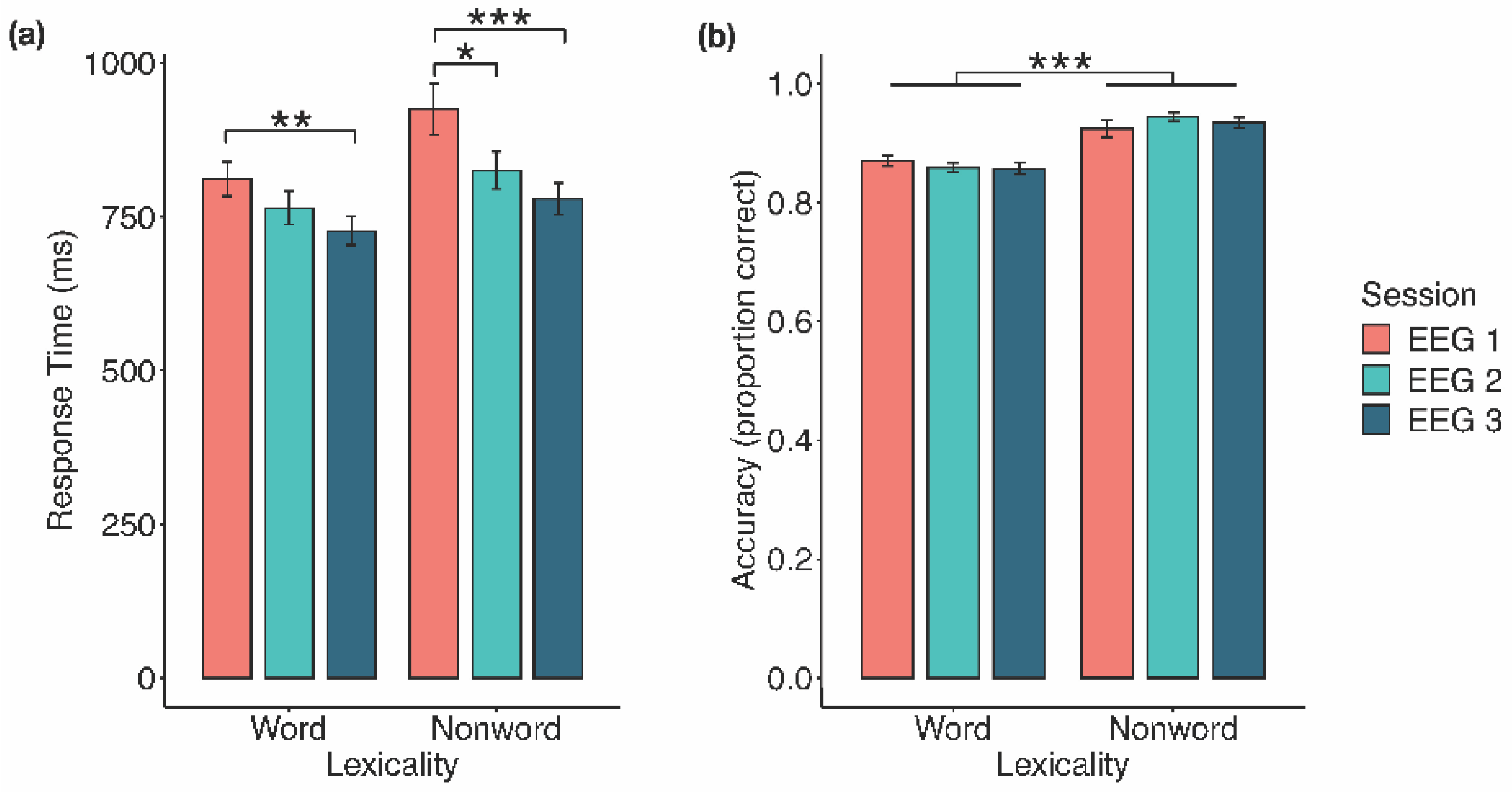
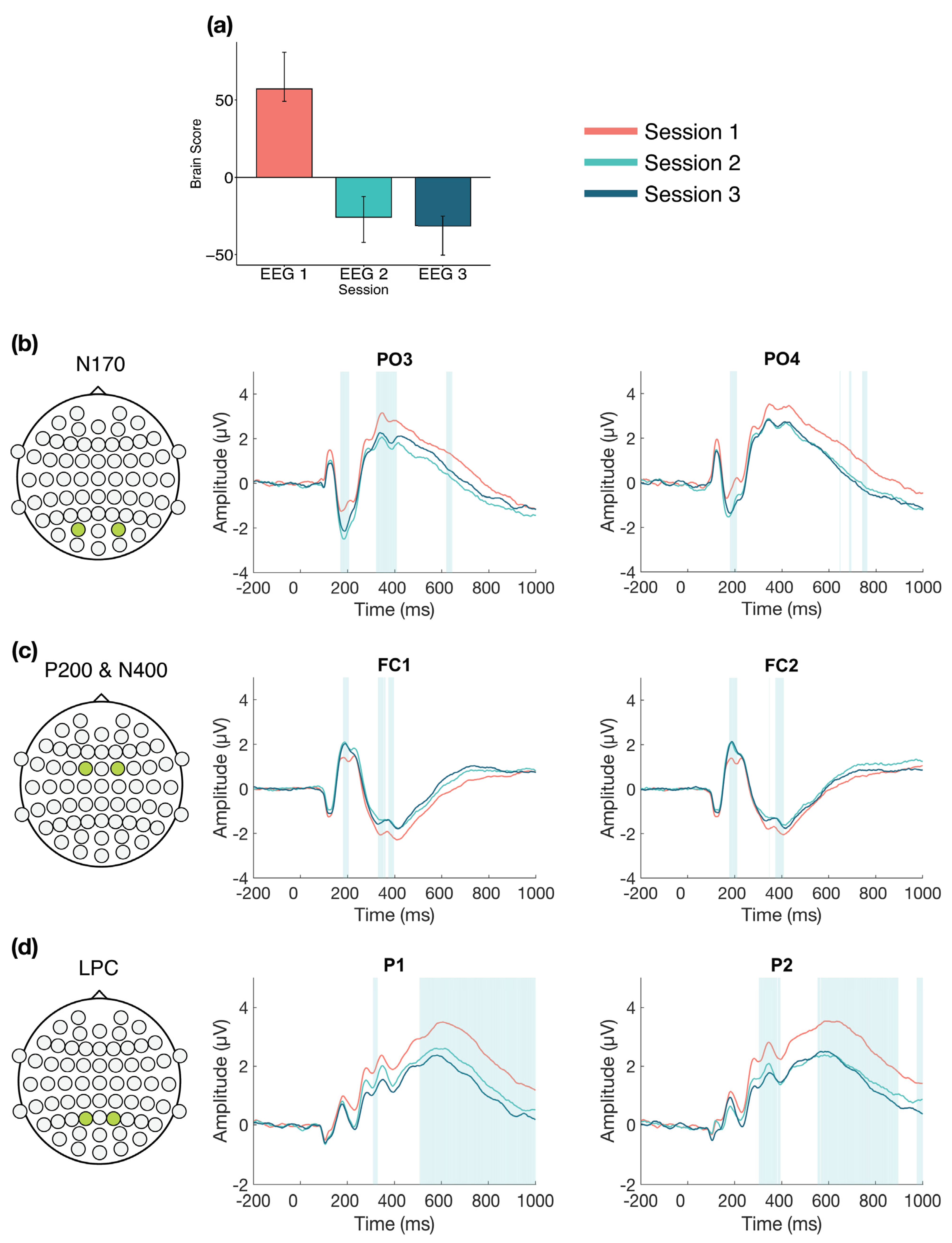

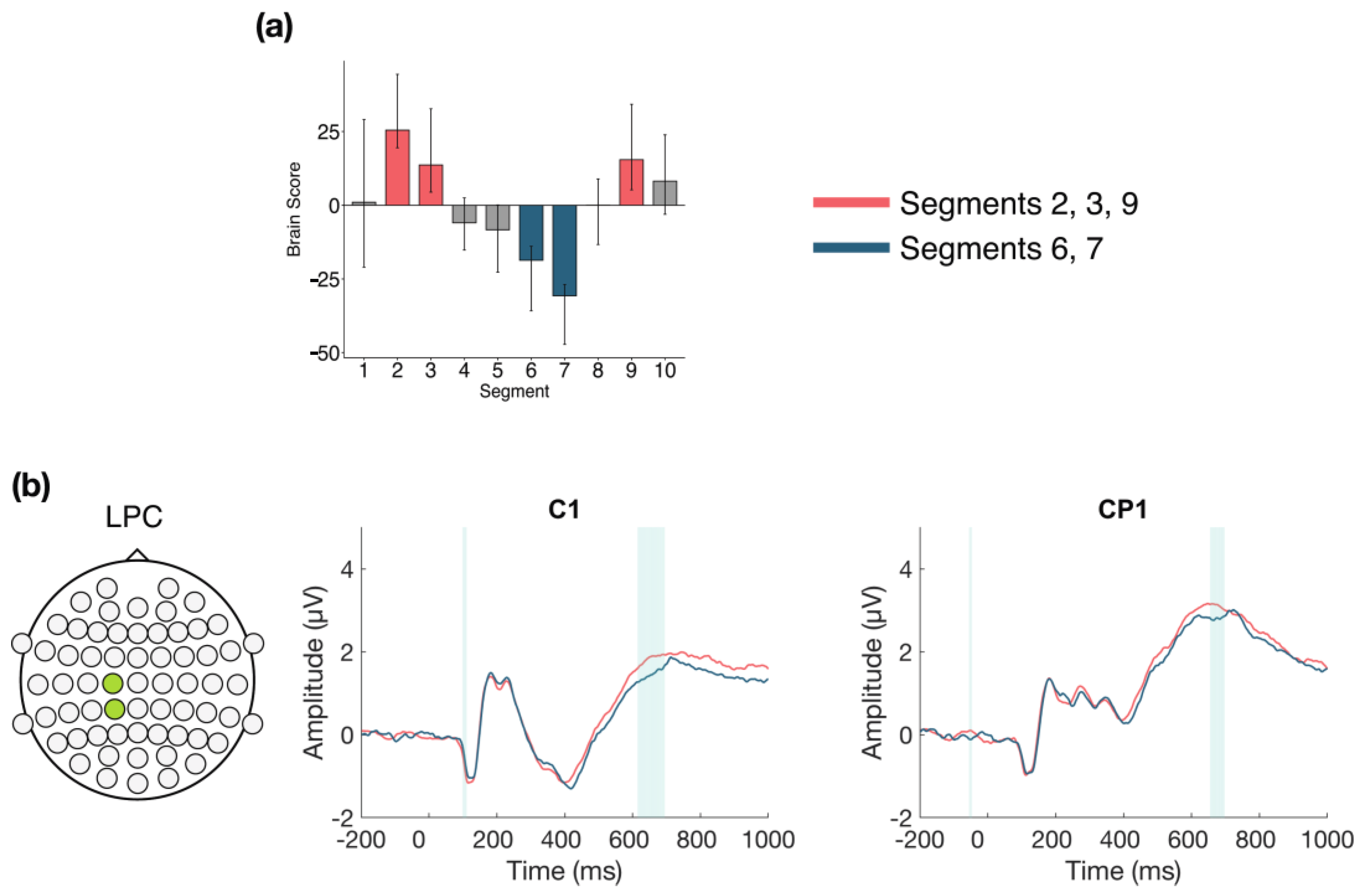
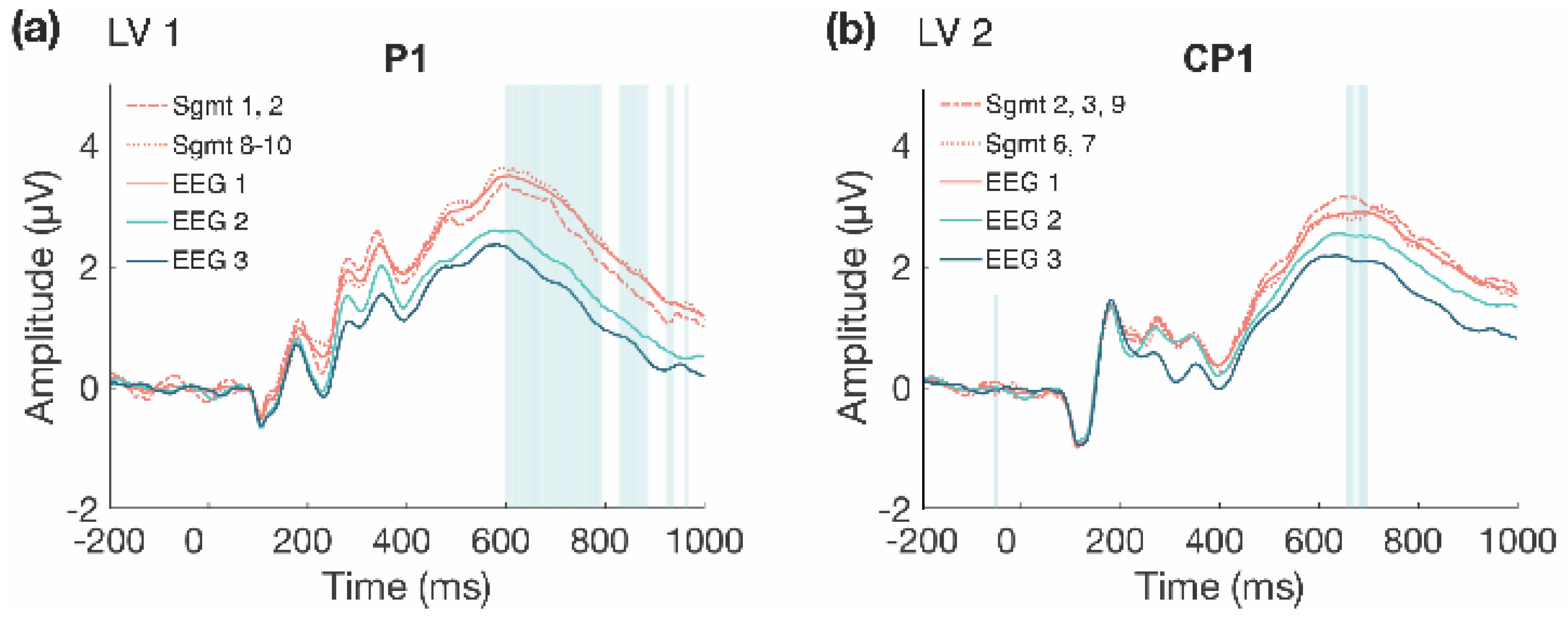
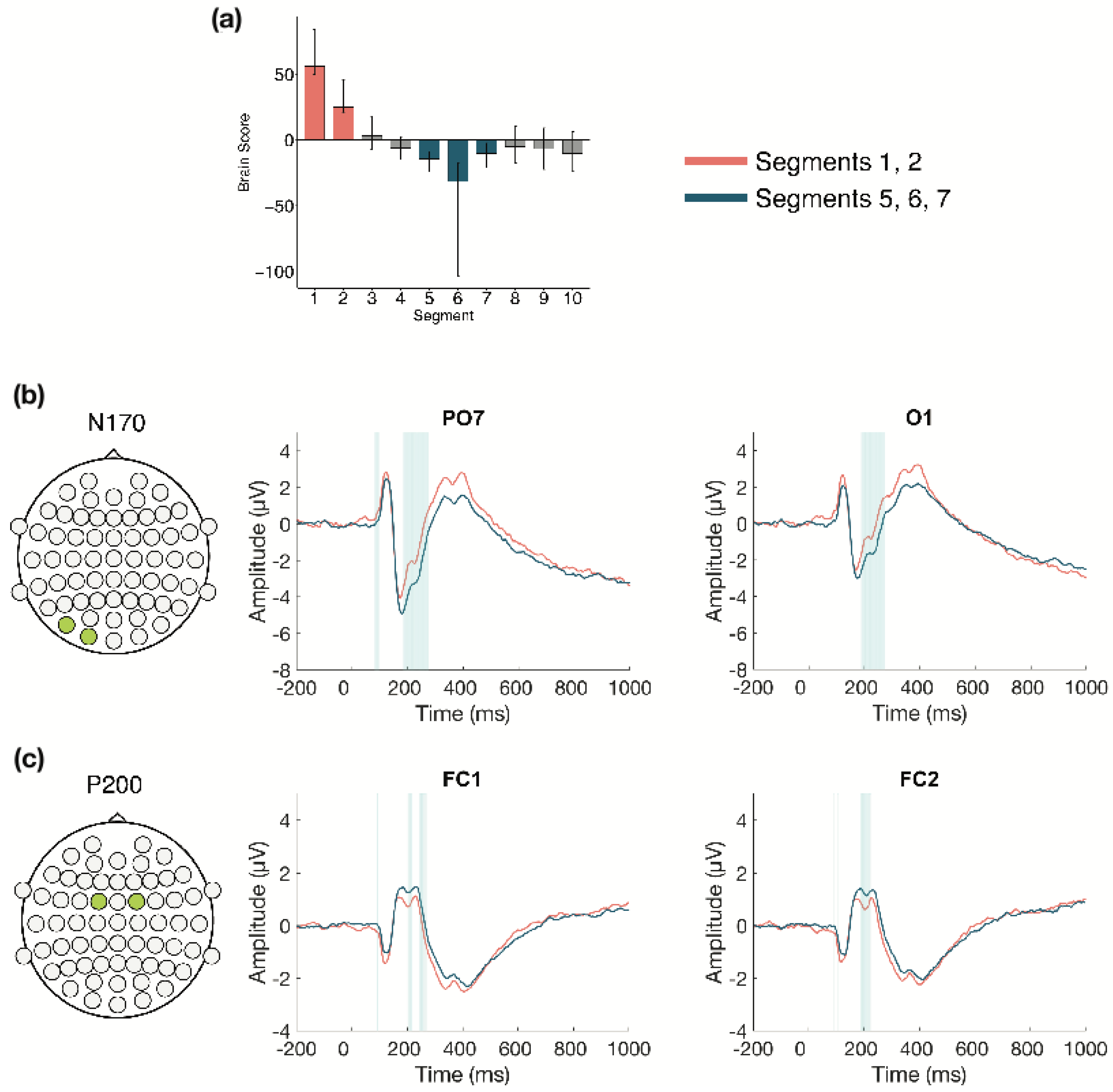
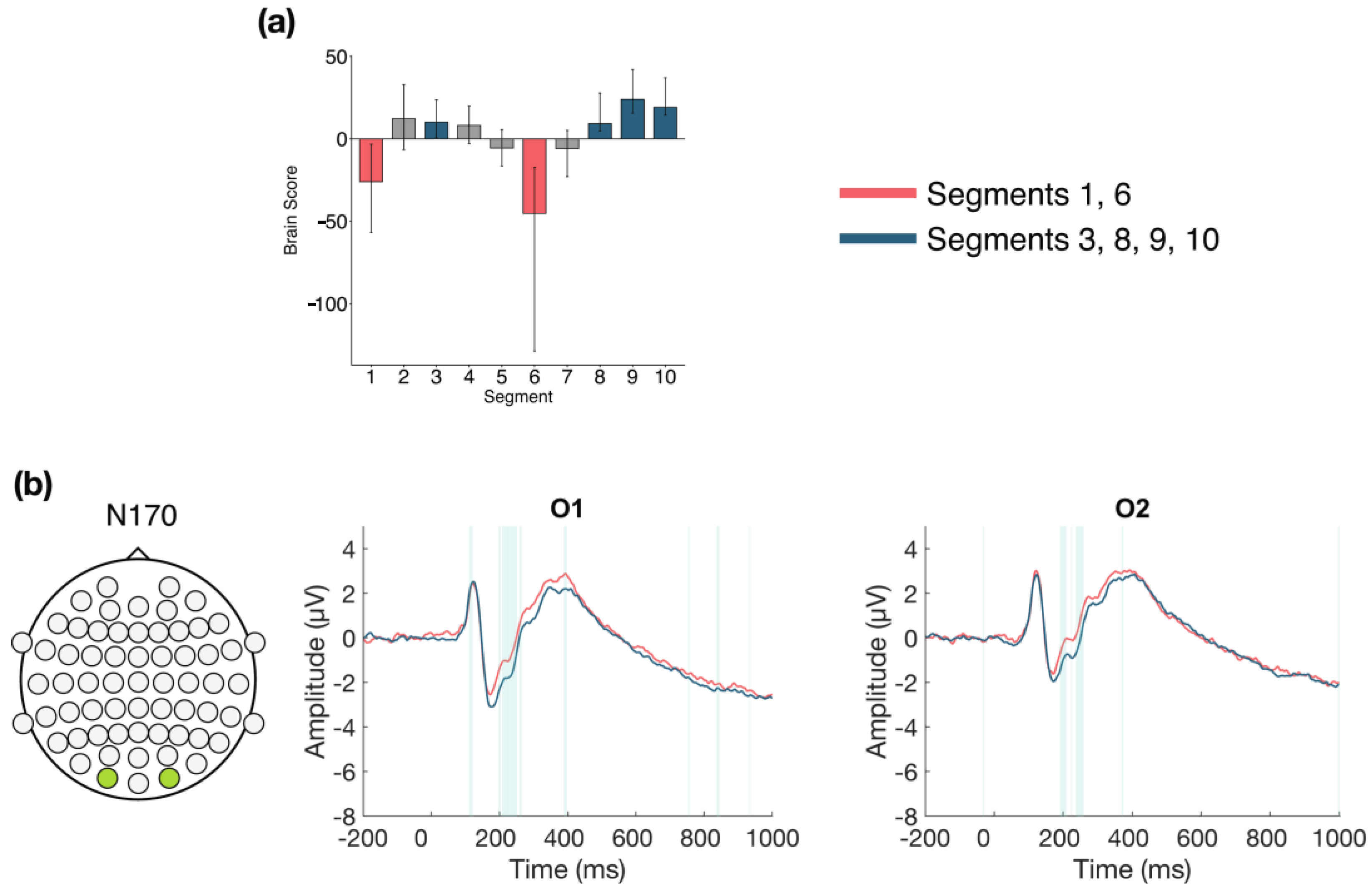
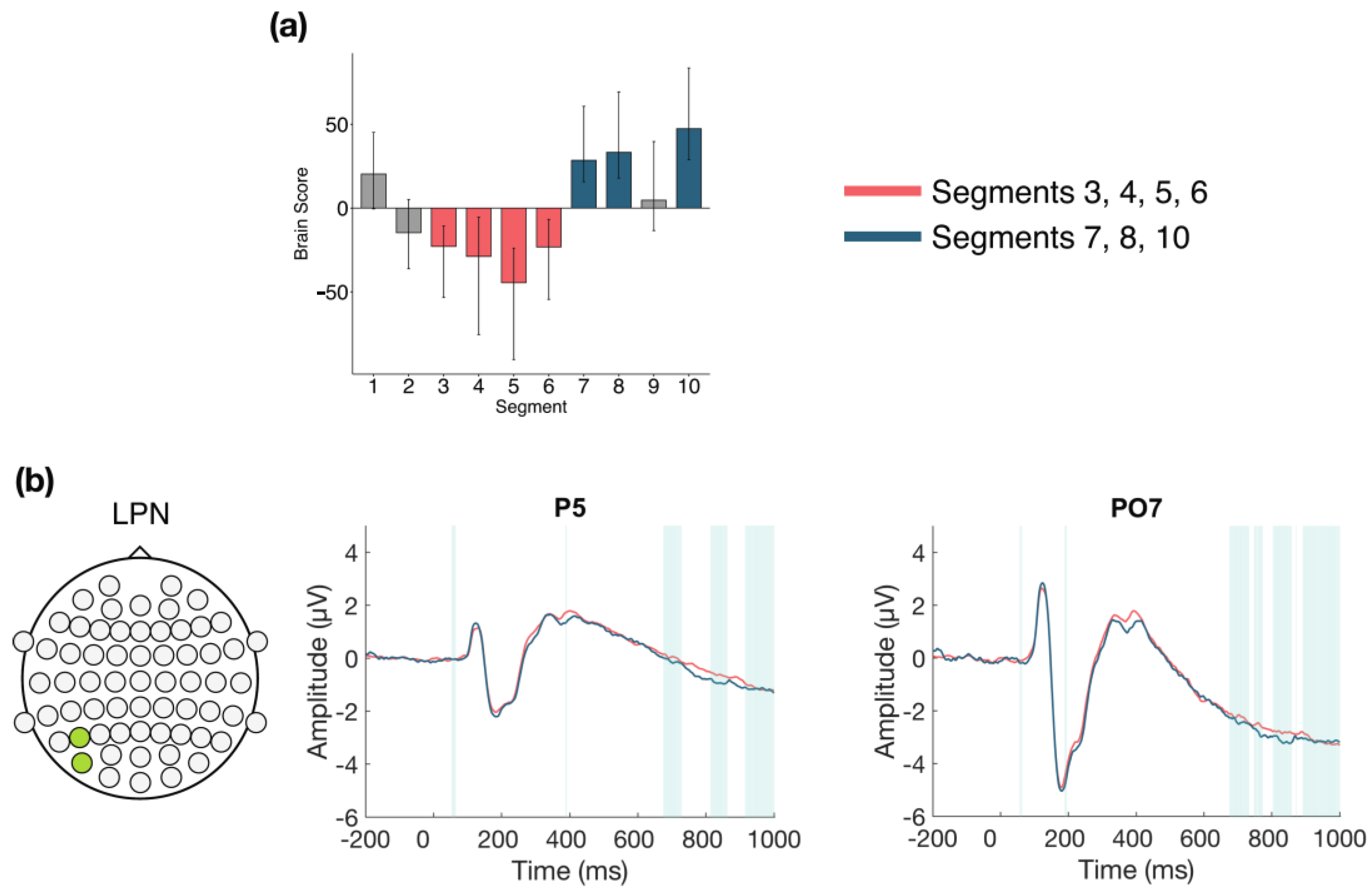
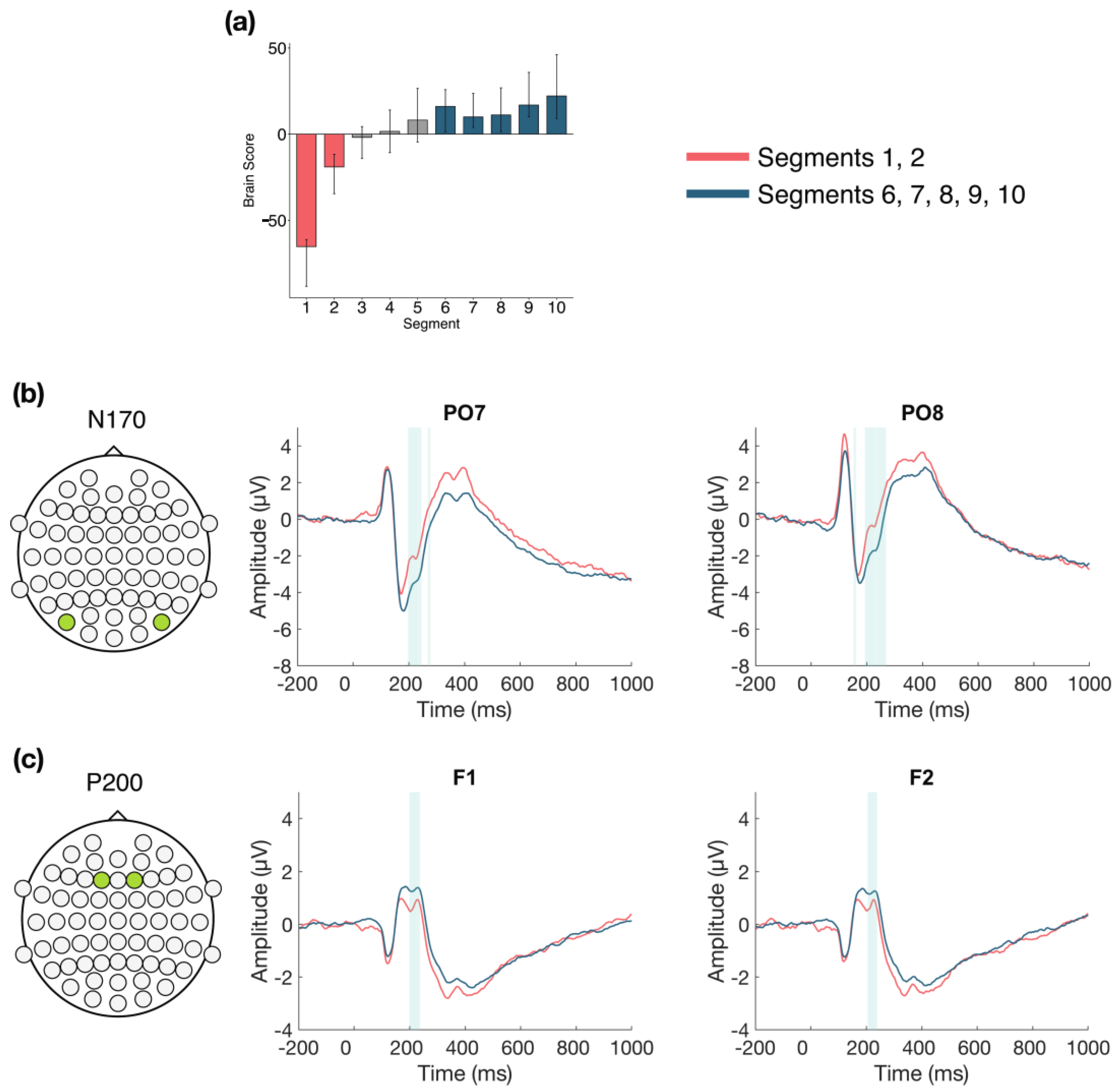
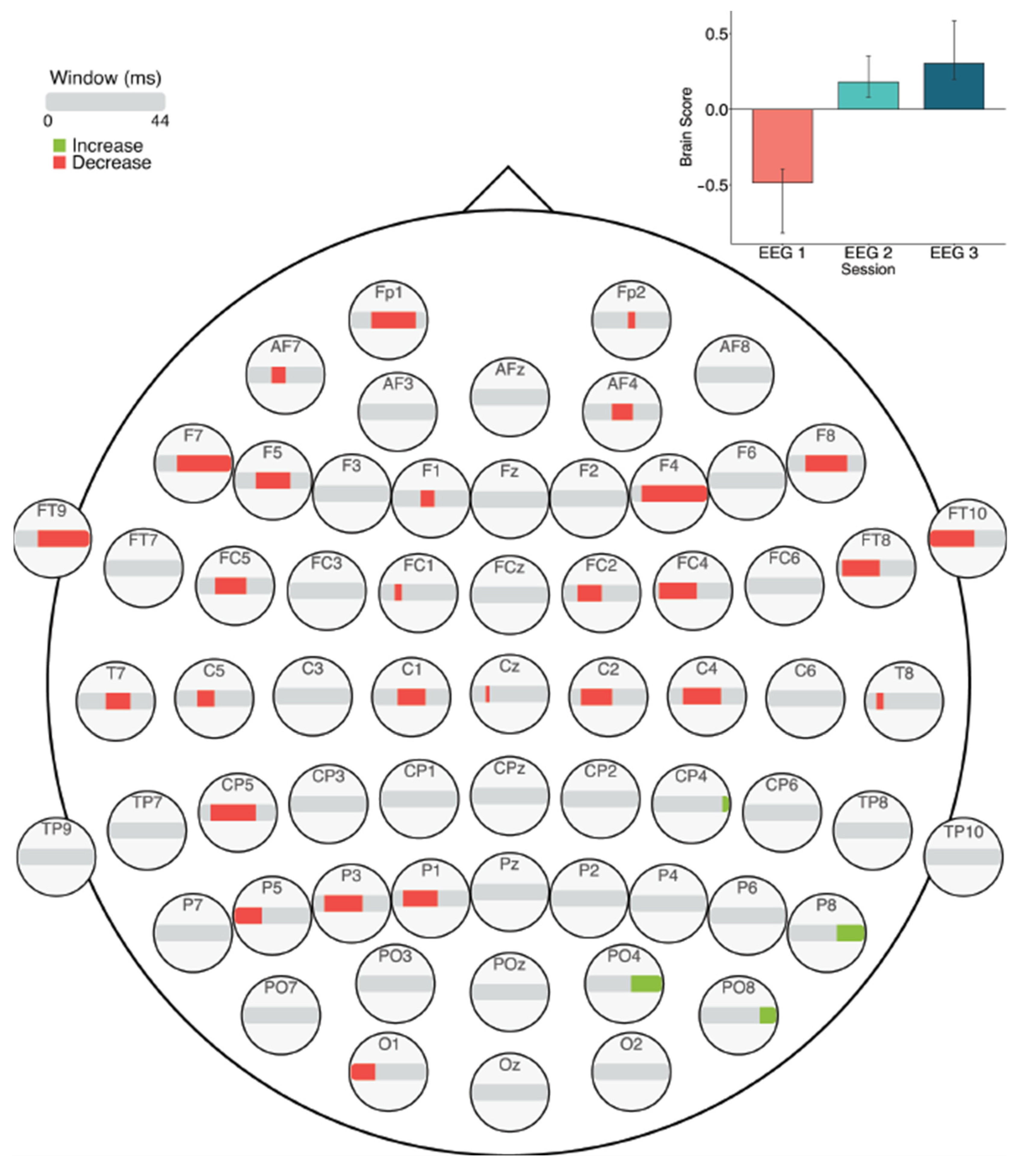

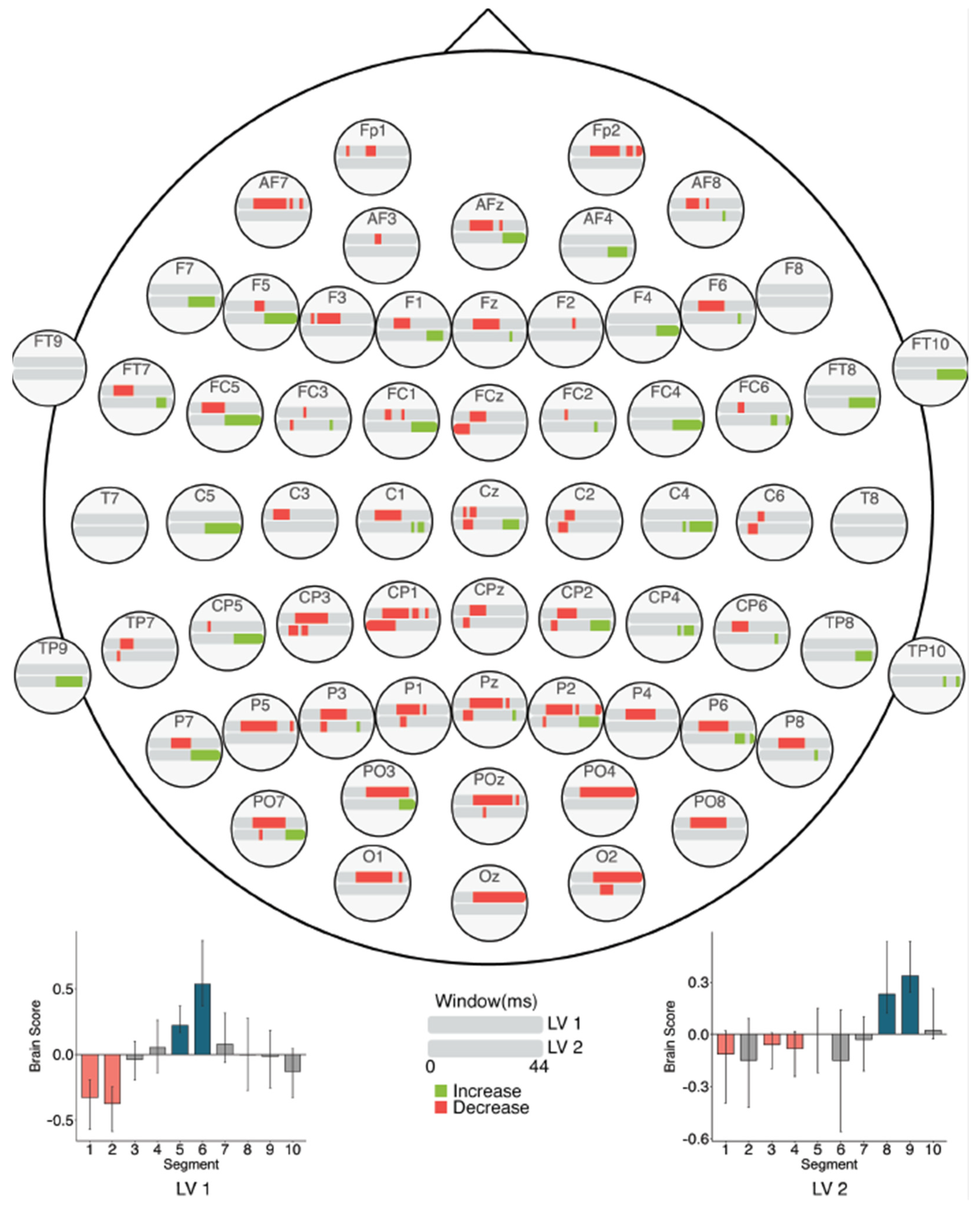
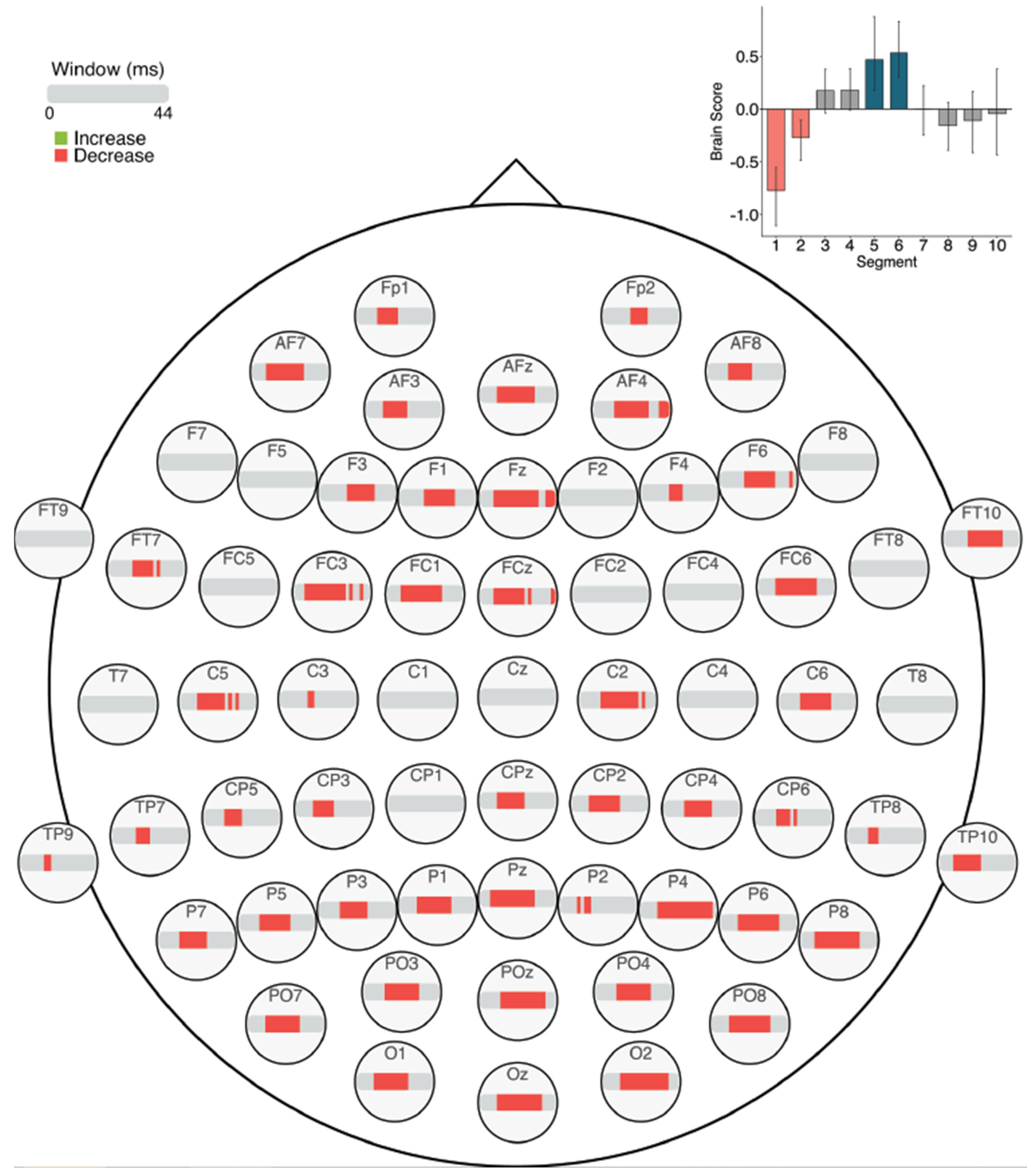
| Response Time (ms) | Accuracy (Proportion Correct) | |||
|---|---|---|---|---|
| M | SD | M | SD | |
| Words | ||||
| Session 1 | 811.16 | 123.41 | 0.87 | 0.04 |
| Session 2 | 763.96 | 120.24 | 0.86 | 0.04 |
| Session 3 | 727.24 | 103.49 | 0.86 | 0.04 |
| Nonwords | ||||
| Session 1 | 924.97 | 185.92 | 0.92 | 0.07 |
| Session 2 | 824.87 | 136.99 | 0.94 | 0.03 |
| Session 3 | 778.75 | 115.08 | 0.93 | 0.04 |
Publisher’s Note: MDPI stays neutral with regard to jurisdictional claims in published maps and institutional affiliations. |
© 2021 by the authors. Licensee MDPI, Basel, Switzerland. This article is an open access article distributed under the terms and conditions of the Creative Commons Attribution (CC BY) license (http://creativecommons.org/licenses/by/4.0/).
Share and Cite
Cnudde, K.; van Hees, S.; Brown, S.; van der Wijk, G.; Pexman, P.M.; Protzner, A.B. Increased Neural Efficiency in Visual Word Recognition: Evidence from Alterations in Event-Related Potentials and Multiscale Entropy. Entropy 2021, 23, 304. https://doi.org/10.3390/e23030304
Cnudde K, van Hees S, Brown S, van der Wijk G, Pexman PM, Protzner AB. Increased Neural Efficiency in Visual Word Recognition: Evidence from Alterations in Event-Related Potentials and Multiscale Entropy. Entropy. 2021; 23(3):304. https://doi.org/10.3390/e23030304
Chicago/Turabian StyleCnudde, Kelsey, Sophia van Hees, Sage Brown, Gwen van der Wijk, Penny M. Pexman, and Andrea B. Protzner. 2021. "Increased Neural Efficiency in Visual Word Recognition: Evidence from Alterations in Event-Related Potentials and Multiscale Entropy" Entropy 23, no. 3: 304. https://doi.org/10.3390/e23030304
APA StyleCnudde, K., van Hees, S., Brown, S., van der Wijk, G., Pexman, P. M., & Protzner, A. B. (2021). Increased Neural Efficiency in Visual Word Recognition: Evidence from Alterations in Event-Related Potentials and Multiscale Entropy. Entropy, 23(3), 304. https://doi.org/10.3390/e23030304





